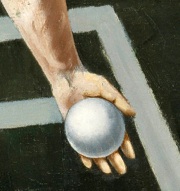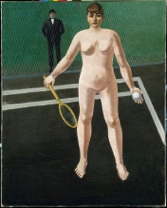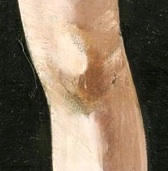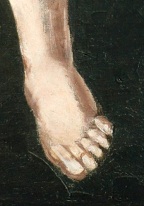Anton Räderscheidt
The Tennis player
The painter of the New Objectivity
1926
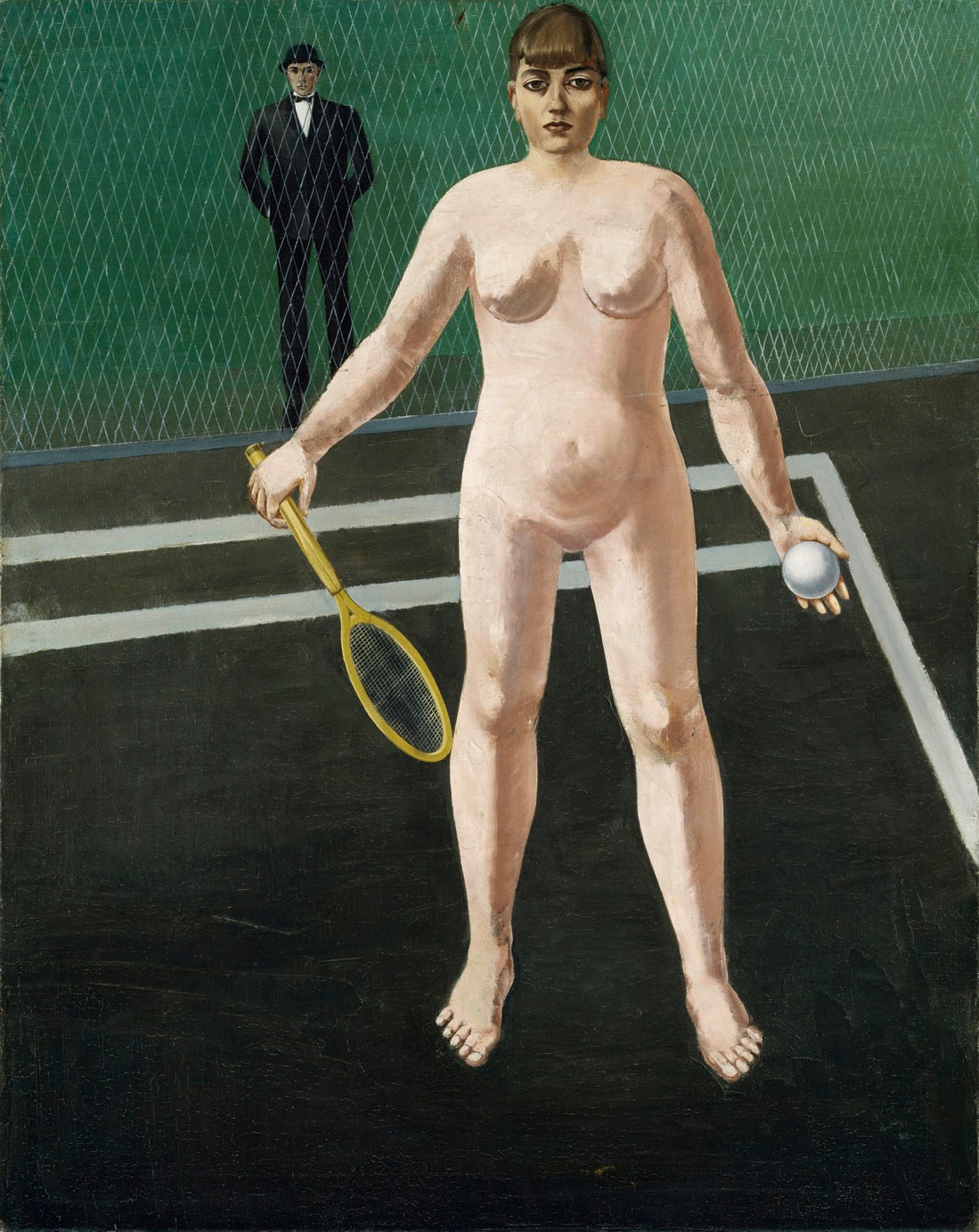
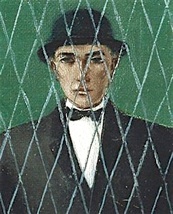
A comparison of two pictures from the Pinakothek der Moderne
Anton Räderscheidt (1892-1970) – The tennis player
Pablo Picasso (1881-1973) – painter and model
The two pictures, which can almost always be seen in the permanent exhibition of the Pinakothek der Moderne and at no great spatial distance from each other, deal with the same topic, even if this is not immediately apparent. However, they come to different results in terms of form and content. The subject belongs to the standard repertoire of occidental painting, it is the man’s gaze at the woman, more precisely the painter’s gaze at the woman, more precisely the gaze of a clothed man – by whom the painter is always meant – at a woman undressed, that is, the female nude, from the point of view of another male figure included in the picture narration. In both pictures, cool, greenish-gray, blue tones contrast with warm, pink, brown or ocher. Räderscheidt assumes that the local colors apply. The broken pink cylinders from which he builds his naked wife are illuminated by the light of an overcast sky and stand out sharply as a bright scissor shape from a dark green tennis lawn. Picasso’s nude is also brighter than all the other parts of the picture, in both the light comes from the left, the nude looks at the viewer and not at the man present in the same picture space.
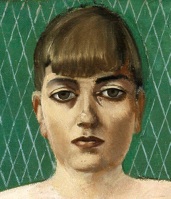
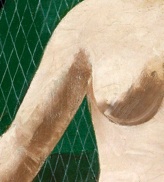
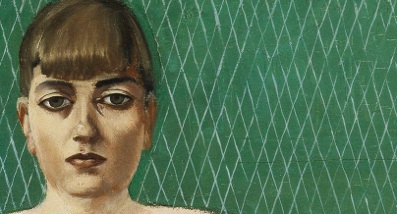
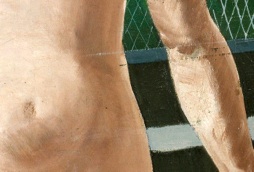
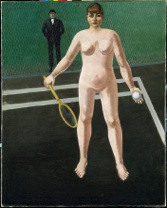
So much for what we have in common.
However, Picasso does not use the warm, light tones (in his case a white ocher, at times heightened to yellow) as descriptives for the model’s skin, but rather places his dark male figure as a kind of backlight that cites the dazzling light of a studio lamp. If you wanted to, you could already smell one of those intellectual games of meaning that Picasso masters like no other. Because it is not the model that receives an incarnate, i.e. a color surface that can be understood as a flesh tone and therefore plausible – the woman’s handle-like arms, where they have not been left white, are framed in Veronese green, breasts, legs are “painted” green (except for a tiny red dot on the belly smeared into white as if by mistake), and it is no coincidence that this green is found again in the tense head of the painter and in his painting hand, which, incidentally, consists of a dash that is known as female shame can read what the arrow-like line marking the brush underlines (the question: what is painting? is posed quite clearly here and it is answered quite clearly, of course from the man’s point of view) – no, it will be light ocher, the more obvious tone for bare skin, used in this picture for something else: it embraces the figure of the painter, who, as if welded together from iron, focuses to the utmost, understands light as an art problem (while the small-headed female nude is in the light of the lamp), the painter is enclosed and oppressed by his pasty, vibrantly painted surfaces, completely “wrapped” in painting.
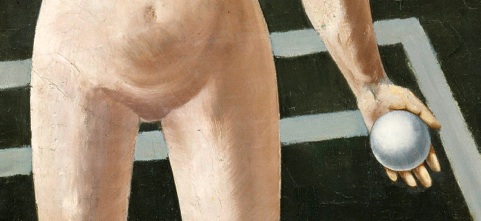
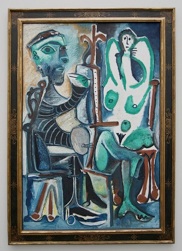
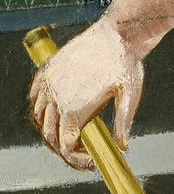
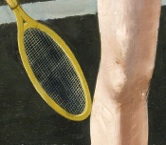

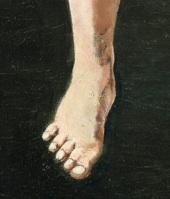
There, in the artist, and that means in the head of the artist, Picasso seems to want to assure that there is knowledge, reflection, artistic conception. It happens in the head! Like the giant eyes on the bow of the ships of the ancient Greeks, the cyclops eye fixes us in the painter’s giant head. The painter is trapped in his vision, excited by the model (of nature) and, as it were, forced to paint pictures by his expanded view.
In this context the polemics of a critic and contemporary of Renoir should be mentioned, who disgustedly associated the greenish shimmering flesh of a nude by Renoir with rotting flesh, reflecting trees and bushes. This is particularly interesting in relation to Picasso, who publicly disdained Bonnard, but his sympathy for the painter “in himself”, who looks at the world with wide eyes like a child and studies his model obsessively, unmistakably in pictures like this one Expressed.
Everything here is an allusion to the sexual desire transformed by the artist into art, to the creative act, which is realized in a formal interlocking of swelling soft and hard protruding forms. In the Munich picture, the chair on which the woman is sitting becomes a prefigurative idol, the lyre essay on the easel, the echo of gently curved limbs (on which the balance of the picture “hangs” like on a hook), brushes push through the pallet hole, aim at the gender of the woman and the easel is always the vertical, the longitude that separates the two hemispheres in the middle of the picture.
Often the design, which is almost forced by the rapid pace of work, makes compromises. In the Munich picture, for example, areas that have been left open in terms of graphics are in contradiction to spatially formulated passages, and overall one has the feeling that the two of them have too little space in the narrow vertical format, especially the man whose chair is wedged between the edge of the picture and a stiff back (tirelessly is he active), an act of violence, such as the brutally scraped off stripes of the worn sweater or this dark blue fender shape that probably means a stomach (or an empty stomach?), which only finds the appropriate reason in the already questionable thigh solution of the seated woman. One detail of the picture is revealing, namely the mixed surface of the palette, which resembles the outline of a head shape (!) And faces the viewer, the only gray surface in the picture. One remembers the ingeniously shocking remark of the agent provocateurs (who at the same time outlined his painterly approach as a whole, as a painter who develops painting out of form), namely: “Color weakens”. And Corot, the great interpreter of young female models sitting deep in himself – pictures that Picasso knew, which inspired him in the almost colorless phase of the cubistically desentimentalized mandolin players – had described gray as the real touchstone of true painting.
Räderscheidt proceeds differently. There is no formal network of relationships between the small, clothed male and the more prominent female nude figure. On the contrary, a net, which is literally mentioned in the picture, separates the two irreconcilably, namely the fence of a tennis court, on which the woman stands without being ashamed of her nakedness. Otherwise, it seems impossible to see the two figures as a whole, or even only as related to each other. The inaccessibility of women is doubly underlined by the white marking of the play area, which, as a double drawn line, quotes duality, but by no means entanglement, but rather hard delimitation, and additionally reinforces the spatially unstable effect of a floor tipping forward. The woman stands on this floor with her legs apart, proud, and confident, she almost seems to be flying, certain of her invincibility, all round shapes – and one could say all shapes in the picture – are assigned to her alone. She holds the ball and tennis racket in her hands like the regal insignia of power and thus parodies the little locked out man. You, the woman, are in control of the game, from the man’s point of view! The man is an outside observer. As a statement on painting, this is a moment that fundamentally differs from Picasso’s statement by an enigmatic pessimism, which, if you will, lacks a virile drive, describes a blockage, depicts a standstill. The gap between the viewer and the viewed (feminine) world is deepened by exaggerating the perspective.
Art – and this picture is about art because the painter brings himself into the action as the observing subject – only seems to arise in a dream, in the unreal world. The areas are separated. Reality is inaccessible, impregnable by the gaze that absorbs it (the man only sees the woman from a distance and from behind). What Picasso’s easel and canvas mark as a permeable threshold is here a wire mesh fence that allows glances to pass through but makes the space that it delimits completely inaccessible. He defines the space of reality (and that of the opposite sex in relation to painting) as an inaccessible and different one.
Consistently this is illustrated here with the means of an illusionistic, almost naive painting describing a world of things, which – in stark contradiction to the disillusioning message of the image – sets the image behind it in a contrapuntal way.
In his picture, Räderscheidt dissonantly summed up the subject of gender-philosophical distress, the sexual dimension of art, the desire for illustration, i.e. the appropriation of a heterogeneous half of the world, which Picasso also intended, while Picasso was about formal reconciliation struggled, even if, as it seems to me, the result was not convincing: an unresolved knot of rods, thumbs and tubes, nails, feet and faces, which works quite well in terms of color, but in the strictly symmetrical structure of the composition , which is reminiscent of the tripartite division of Gothic cathedral facades, creates references that are too narrow, as if the painter had adhered to a grid that was too small when linking and intertwining the forms.
The tennis player is part of the permanent collection in the:
Pinakothek der Moderne
Barer Straße 40
Öffnungszeiten
Täglich außer Mo 10.00 – 17.00
Do, Fr 10.00 – 20.00
